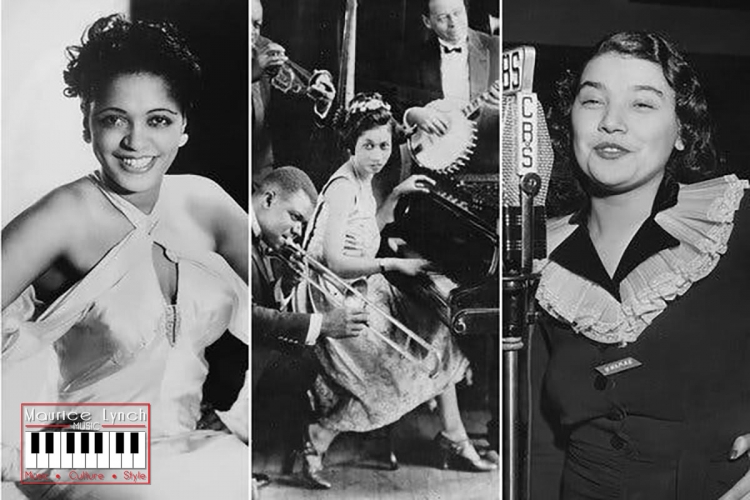Latest News and Updates
MAURICE LYNCH MUSIC: CELEBRATES APRIL NATIONAL JAZZ APPRECIATION MONTH - 10 Women in Jazz Who Never Got Their Due

Maurice Lynch Music: Valaida Snow,Lil Hardin Armstrong & Una Mae Carlisle. 3 Great Musicians in Jazz
Growing out of the deep south at the turn of the 20th century and working its way up the Mississipi Delta, jazz influenced musicians along the way. As it grew, it inspired more improvisation, and as a result, new methods formed and new styles of music, too. Music and jazz were developing and changing quickly. The impact of jazz on the country was profound.
Kick back and listen to the sound of history as you listen to Miles Davis or any modern-day jazz musician. Let the music move you.
We’re often taught to think of jazz’s history as a cavalcade of great men and their bands, but from its beginnings the music was often in the hands of women. Listen to some of the greatest.
10 Women in Jazz Who Never Got Their Due
Young, female instrumentalists have been establishing a firmer footing in jazz, taking some of the music’s boldest creative steps and organizing for change on a structural level. But this isn’t an entirely new development.
While we’re often taught to think of jazz’s history as a cavalcade of great men and their bands, from its beginnings in the early 20th century women played a range of important roles, including onstage. During World War II, right in the heart of the swing era, all-female bands became a sensation, filling the void left by men in the military. But in fact they were continuing a tradition that had begun in the vaudeville years and continued, albeit to a lesser degree, in jazz’s early decades.Prevented from taking center stage, many female instrumentalists became composers, arrangers or artists’ managers. Buffeted by sexism from venue owners and record companies in the United States, they often went abroad to pursue careers in Europe or even Asia. As was also true of their male counterparts, the African-American women who helped blaze some of jazz’s earliest trails had to innovate their way around additional roadblocks.
“These jazz women were pioneers, and huge proponents in disseminating jazz and making it a global art form,” said Hannah Grantham, a musicologist at the National Museum of African American History and Culture who studies the work of female jazz musicians and contributed notes to this list. “I don’t think they’ve been given enough credit for that, because of their willingness to go everywhere.” The piano and organ were considered more socially acceptable instruments for young women to play, and few serious fans of jazz would be unfamiliar with the names Mary Lou Williams, Marian McPartland, Hazel Scott, Shirley Scott or Alice Coltrane. But the ranks of female jazz genius run much deeper than that. Here are 10 performers who made a big impression in their day, but are rarely as remembered as they should be in jazz’s popular history.
Lovie Austin, Pianist (1887-1972)
Lovie Austin composed for and accompanied some of the greatest singers of the early recording era, including Ma Rainey and Ethel Waters. A number of her songs became hits, including “Down Hearted Blues,” a smash for Bessie Smith that sold close to 800,000 copies. Based in Chicago, Austin was also a frequent bandleader at some of the Harlem Renaissance’s most famous venues. Mary Lou Williams counted Austin as her largest inspiration. “My entire concept was based on the few times I was around Lovie Austin,” she later said.
Lil Hardin Armstrong, Pianist (1898-1971)
Lil Hardin met her future husband Louis Armstrong in 1922, when he joined her as a member of King Oliver’s famed Creole Jazz Band. Hardin, who studied at Fisk University and had an entrepreneurial streak, helped bring Armstrong forward as a bandleader, serving as his first manager, pianist and frequent co-composer. After they split up around 1930, she found some success with her own big band, but stepped away from performing years later after determining that male promoters would never be willing to promote her on the same level as men.
Valaida Snow, Trumpeter (1904-1956)
Valaida Snow’s career was a wildfire: a thing of great expanse and then rapid, wrenching exhaustion. She was a master of the trumpet but played a dozen other instruments, as well as singing, doing arrangements for orchestras, dancing, and appearing prominently in early Hollywood films. When the pioneering blues musician and composer W.C. Handy heard her play, he dubbed her “Queen of the Trumpet.” Denied a proper spotlight in Chicago and New York, Snow became a star abroad, touring for years in East Asia and Europe. She wound up stuck in Denmark during World War II, becoming ill while imprisoned there. She escaped in 1942 and spent the rest of her career back in the United States, although her health never recovered.
Peggy Gilbert, Saxophonist (1905-2007)
As a grade-school student in Sioux City, Iowa, Peggy Gilbert quickly became accustomed to cutting against the grain. The daughter of classical musicians, she was told in high school that the saxophone was unsuitable for a young woman — but she taught herself anyway. A year after graduating she started her first band, the Melody Girls. In 1938, outraged at an article in DownBeat magazine headlined “Why Women Musicians Are Inferior,” she penned a retort that the magazine published in full. “A woman has to be a thousand times more talented, has to have a thousand times more initiative even to be recognized as the peer of the least successful man,” she wrote. Talent and initiative were two things Gilbert possessed. She went on to lead ensembles for decades, on the vaudeville circuit and the Los Angeles scene, eventually becoming an official with the musicians’ union there. She continued to perform well into her 90s, and died at 102.
Una Mae Carlisle, Pianist (1915-1956)
Just like better-remembered contemporaries such as Fats Waller and Louis Jordan, Una Mae Carlisle made jazz that was also R&B and also pop — before the Billboard charts had effectively codified those genres. She was publicly known best as a singer, but she played virtuosic stride piano and composed prolifically too. Part black and part Native American, Carlisle was a pioneer in various ways, as Ms. Grantham pointed out. Carlisle was the first black woman to be credited as the composer of a song on the Billboard charts, and the first African-American to host her own regular, nationally broadcast radio show. She wrote for stars like Benny Goodman and Peggy Lee, and recorded her own hit singles, often with famous jazz musicians as her accompanists, before illness tragically shortened her career.
Ginger Smock, Violinist (1920-1995)
Orphaned at age 6 and subsequently raised by her aunt and uncle, Ginger Smock showed extravagant talents early on. At 10, she performed at the Hollywood Bowl; a year later, she gave a solo recital at the First African Methodist Episcopal Church of Los Angeles. She was the only black member of the Los Angeles Junior Philharmonic’s all-student symphony, and soon after she apprenticed with the jazz pioneer Stuff Smith. She then started an all-female trio, the Sepia Tones, that was a centerpiece of the city’s burgeoning Central Avenue jazz scene, and she soon became “pretty influential on the West Coast,” Ms. Grantham said. Later, Smock hosted a full-length (though short-lived) show on Los Angeles’s CBS affiliate, KTSL, in 1951, making hers the first black band to host a regular TV program.
Dorothy Donegan, Pianist (1922-1998)
A blazing player whose personality was as big and effusive as her talents, Dorothy Donegan piled her mastery of classical, stride, boogie-woogie and modern jazz piano into boisterous, often ribald performances. An old-school performer at heart, she could amaze and amuse an audience in equal measure. Donegan’s career was book ended by illustrious performances: In 1943, with dreams of becoming a professional classical pianist, she became the first black instrumentalist to give a concert at Orchestra Hall in Chicago. Time magazine covered it, and it set her on a path to renown, although a career in classical music was off-limits because of both her gender and her race. Fifty years later, she performed at the White House for President Bill Clinton. For all her accomplishments, Donegan made it clear in interviews that she felt sexism had prevented her from joining her male contemporaries in the music’s pantheon.
Jutta Hipp, Pianist (1925-2003)
Hailing from Leipzig, Germany, Jutta Hipp taught herself jazz as a child growing up in the Third Reich, secretly listening to international radio broadcasts. She was forced to flee her hometown at age 21, after the war left it in ruin; she supported herself by becoming a professional jazz pianist. Hipp eventually became the first woman bandleader to record for Blue Note Records, whose proprietors were German expatriates. But with true stardom escaping her, she eventually abandoned her career although she never totally gave up playing.
Clora Bryant, Trumpeter (1927-2019)
A self-proclaimed “trumpetiste,” Clora Bryant was part of the first generation of bebop musicians innovating in Los Angeles clubs, and she joined a handful of all-female ensembles in the years during and after World War II. Bryant became a featured soloist in the International Sweethearts of Rhythm, the most famous ensemble of its kind, then joined the Queens of Rhythm. Through the esteemed trombonist Melba Liston she met Dizzy Gillespie, who became her mentor. And as her career went on, she mentored countless musicians herself as a respected elder on the L.A. scene.
Bertha Hope Booker, Pianist (1936-)
Bertha Hope’s career bloomed alongside that of her husband Elmo Hope, whose economic hard-bop style was not altogether different from hers. They released a joint album together in 1961, but after his untimely death she focused on raising their children, performing intermittently around the New York area and remaining close with many musicians on the scene. Years later, she remarried, to the bassist Walter Booker; since then she has recorded a handful of albums and become a respected elder among younger New York musicians, including the bassist Mimi Jones, who recently made a documentary about her mentor titled “Seeking Hope.”
https://www.nytimes.com/2020/04/22/arts/music/women-jazz-musicians.html
http://mauricelynchmusic.com/
#MauriceLynchMusic
#JazzAppreciationMonth
